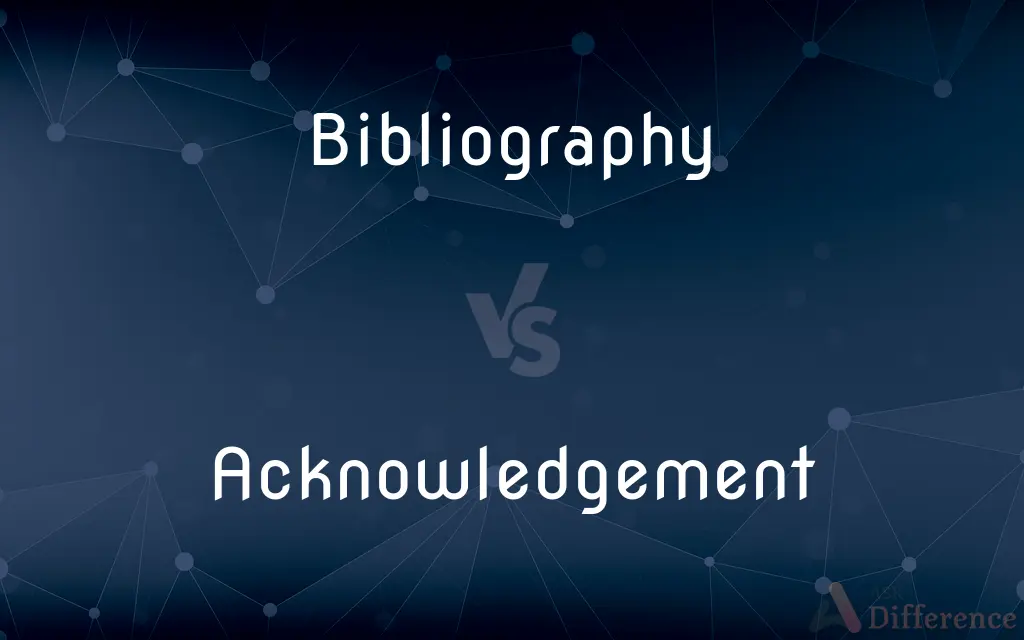Bibliography vs. Acknowledgement — What's the Difference?
Edited by Tayyaba Rehman — By Urooj Arif — Updated on May 6, 2024
A bibliography is a list of sources cited or consulted in the creation of a work, usually placed at the end of a document, while an acknowledgment section gives credit to individuals or organizations that contributed assistance or support to the work.

Difference Between Bibliography and Acknowledgement
Table of Contents
ADVERTISEMENT
Key Differences
A bibliography includes detailed references such as books, articles, and other sources that the author has either cited in the text or used for research, organized typically in a specific citation style. Whereas, acknowledgments are written notes of appreciation for support and help received during the writing or research process.
The function of a bibliography is to provide readers with the sources to verify or further explore information presented in the document. On the other hand, acknowledgments serve a more personal function, expressing gratitude to those who contributed indirectly to the project.
Bibliographies are essential in academic and research contexts for substantiating claims and providing a basis for further research, highlighting the author’s diligence in research. In contrast, acknowledgments do not influence the scholarly content of the work but enhance its ethical presentation by recognizing contributions.
The content of a bibliography is strictly academic and related to the research topic, featuring author names, titles, publication details, and sometimes annotations. Acknowledgments, however, can be more personal and varied, mentioning anyone from a project advisor to family members or even funding bodies.
Formatting for bibliographies is dictated by academic standards such as APA, MLA, or Chicago style guides, which specify how to list sources. Acknowledgments, while less formal, are typically placed either at the beginning or end of a thesis, book, or paper, without a specific format.
ADVERTISEMENT
Comparison Chart
Definition
List of sources used or cited in a document.
Section giving thanks to those who helped the author.
Purpose
To provide source details for verification and further study.
To express gratitude and recognize contributions.
Presence in Document
Usually mandatory in academic works.
Optional, based on personal choice and ethical considerations.
Content Type
Academic and research-related.
Personal and varied.
Format
Governed by specific citation styles.
Informal, with no strict guidelines on placement.
Compare with Definitions
Bibliography
Organized according to a particular citation style.
Her bibliography was formatted according to the latest APA guidelines.
Acknowledgement
Can include advisors, family, friends, and funding agencies.
His acknowledgment thanked both his family for their support and the grant that funded his research.
Bibliography
Essential for academic credibility and research integrity.
The meticulous bibliography reinforced the thesis's credibility.
Acknowledgement
Less formal and more personal than other sections of academic work.
His acknowledgments were warm and included personal anecdotes.
Bibliography
A detailed list of sources used or cited in creating a work.
The book ended with a comprehensive bibliography of all sources.
Acknowledgement
A section of a document where the author thanks those who contributed to the work.
She wrote a heartfelt acknowledgment to her mentor.
Bibliography
Can include books, articles, websites, and other scholarly materials.
His bibliography included several peer-reviewed journals and eBooks.
Acknowledgement
Typically found in theses, books, and major projects.
The book’s acknowledgment page highlighted contributions from various scholars.
Bibliography
Serves as a roadmap for readers to follow the research trail.
The students used the thesis's bibliography to locate primary sources for their projects.
Acknowledgement
Expresses gratitude and recognizes non-scholarly support.
The acknowledgment in her dissertation highlighted the emotional support from her peers.
Bibliography
Bibliography (from Ancient Greek: βιβλίον, romanized: biblion, lit. 'book' and -γραφία, -graphía, 'writing'), as a discipline, is traditionally the academic study of books as physical, cultural objects; in this sense, it is also known as bibliology (from Ancient Greek: -λογία, romanized: -logía). English author and bibliographer John Carter describes bibliography as a word having two senses: one, a list of books for further study or of works consulted by an author (or enumerative bibliography); the other one, applicable for collectors, is "the study of books as physical objects" and "the systematic description of books as objects" (or descriptive bibliography).
Acknowledgement
The act of admitting the existence or truth of something
Acknowledgment that the service was poor.
Bibliography
A list of the works of a specific author or publisher.
Acknowledgement
Recognition or notice
Peace based on acknowledgment of a nation's sovereignty.
Bibliography
A list of writings relating to a given subject
A bibliography of Latin American history.
Acknowledgement
An expression of thanks or appreciation
Included acknowledgments of people who helped in making the book.
Bibliography
A list of writings used or considered by an author in preparing a particular work.
Acknowledgement
An answer or response in return for something
Sent an acknowledgment of receipt of the letter.
Bibliography
The description and identification of the editions, dates of issue, authorship, and typography of books or other written material.
Acknowledgement
(Law) The formal avowal of an act before a legally empowered officer, such as a judge or notary public, to ensure that the act will be legally recognized.
Bibliography
A compilation of such information.
Acknowledgement
Alternative spelling of acknowledgment
Bibliography
A section of a written work containing citations, not quotations, to all the books referred to in the work.
Acknowledgement
The state or quality of being recognized or acknowledged;
The partners were delighted with the recognition of their work
She seems to avoid much in the way of recognition or acknowledgement of feminist work prior to her own
Bibliography
A list of books or documents relevant to a particular subject or author.
Acknowledgement
A statement acknowledging something or someone;
She must have seen him but she gave no sign of acknowledgment
The preface contained an acknowledgment of those who had helped her
Bibliography
The study of the history of books in terms of their classification, printing and publication.
Bibliography
A history or description of books and manuscripts, with notices of the different editions, the times when they were printed, etc.
Bibliography
A list of books or other printed works having some common theme, such as topic, period, author, or publisher.
Bibliography
A list of the published (and sometimes unpublished) sources of information referred to in a scholarly discourse or other text, or used as reference materials for its preparation.
Bibliography
The branch of library science dealing with the history and classification of books and other published materials.
Bibliography
A list of writings with time and place of publication (such as the writings of a single author or the works referred to in preparing a document etc.)
Common Curiosities
What types of sources are included in a bibliography?
Books, journal articles, websites, interviews, and any other sources consulted.
Why is a bibliography important in academic writing?
It provides a foundation for the work’s credibility and aids in further research.
Is it necessary to follow a specific format for a bibliography?
Yes, bibliographies should follow specific academic citation styles like APA, MLA, or Chicago.
How detailed should an acknowledgment be?
It should be concise yet sufficient to sincerely thank all who contributed significantly.
Where is the acknowledgment section usually placed in a thesis?
It is typically placed at the beginning of the thesis, after the title page and before the abstract.
Can a bibliography be both a part of the text and standalone?
Yes, it can be integrated into footnotes or endnotes and also appear as a comprehensive list at the document’s end.
Can acknowledgments affect the perception of a paper?
While they don’t affect the scholarly merit, they can enhance the ethical perception by recognizing all contributors.
Who is typically mentioned in an acknowledgment?
Advisors, colleagues, research participants, friends, family, and financial supporters.
How can one decide what citation style to use for a bibliography?
This decision is often dictated by the academic discipline or publication guidelines.
What are the ethical considerations for acknowledgments in scientific papers?
Ethically, it’s important to recognize funding sources and anyone who contributed intellectually or materially to the research.
Share Your Discovery

Previous Comparison
Beaver vs. Otter
Next Comparison
Harbinger vs. HeraldAuthor Spotlight
Written by
Urooj ArifUrooj is a skilled content writer at Ask Difference, known for her exceptional ability to simplify complex topics into engaging and informative content. With a passion for research and a flair for clear, concise writing, she consistently delivers articles that resonate with our diverse audience.
Edited by
Tayyaba RehmanTayyaba Rehman is a distinguished writer, currently serving as a primary contributor to askdifference.com. As a researcher in semantics and etymology, Tayyaba's passion for the complexity of languages and their distinctions has found a perfect home on the platform. Tayyaba delves into the intricacies of language, distinguishing between commonly confused words and phrases, thereby providing clarity for readers worldwide.
















































